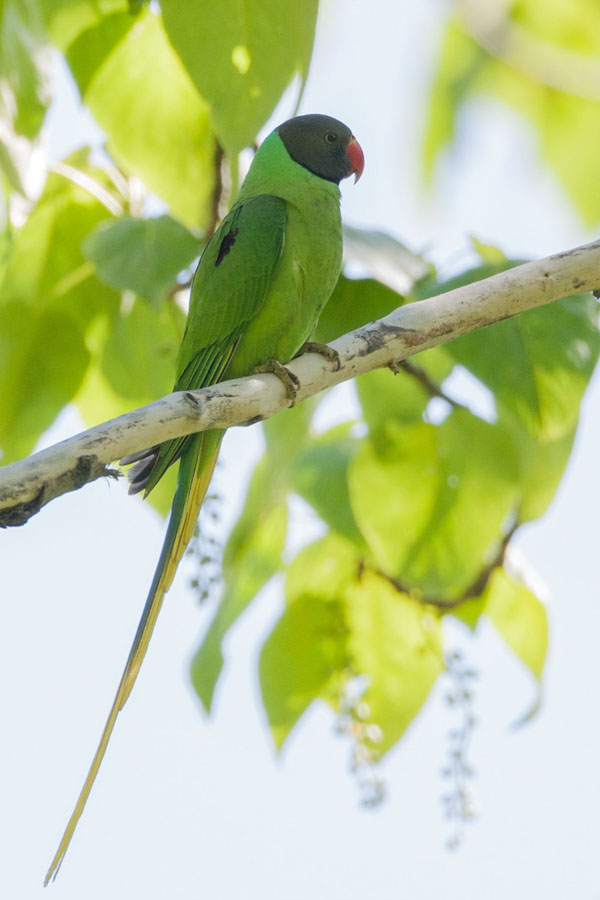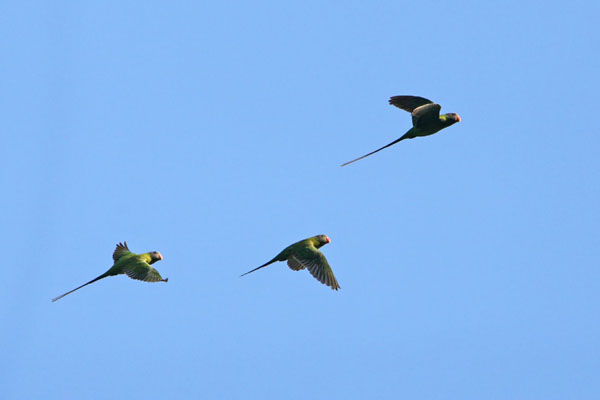Psittacula himalayana
IUCN
LCBasic Information
Scientific classification
- name:Psittacula himalayana
- Scientific Name:Psittacula himalayana,Slaty-headed Parakeet,Gray-headed parrot, Sand monk bird, Gray-headed conure, Dark-headed parrot
- Outline:Climbing birds
- Family:Psittaciformes Psittacidae R.parrots
Vital signs
- length:25一45cm
- Weight:79—119g
- lifetime:25-30years
Feature
The bird's beak is strong and powerful enough to eat hard-shelled fruits.
Distribution and Habitat
It is a resident bird in Yunnan and southwestern Sichuan in China. It is found abroad from the eastern Himalayas to Southeast Asia.
It lives in subtropical mountain broad-leaved forests, distributed up to 2,700 meters above sea level. It moves in small groups and sometimes goes to mountain farms to forage for grains.
Appearance
The bird is green, with a dark grey head with some light blue, a black throat, characteristic chestnut shoulder spots, and an extended tail with yellow tips, similar in appearance to the flower-headed parrot, with a black throat and a darker grey head. The iris is yellow, the upper jaw of the beak is scarlet, the tip of the beak is yellow, the lower jaw is yellow, and the feet are grey or flesh-coloured.
Details
Gray-headed parrots are typical climbing birds with opposable feet, two toes forward and two toes backward, suitable for grasping. The beak is strong and powerful, and can eat hard-shelled fruits. Inhabits forests, palm groves, open plains, woodlands, agricultural areas, etc. They usually live in pairs or small groups, and their main food is fruits, berries, seeds, nuts, flowers and plant buds. They can cause considerable damage to walnuts, apples, peaches, and orchard fruits.

During the breeding season, they will form groups of about 4 to 6 individuals, and at night they will gather in large groups near roosting trees; in some areas, they have the habit of seasonal migration, going back and forth between different heights; usually quite large They are noisy, so they are very visible; they sometimes gather together with the purple-headed parrots and flower-headed parrots of the same genus; their flying skills are quite good, and the whole group of parrots often make sharp turns among the trees and then land on the highest branches, flying Sometimes accompanied by a harsh cry.

Their breeding season in Afghanistan and India is from March to May; in Myanmar it is from January to March; most of them will look for dead tree holes and abandoned tree holes used by woodpeckers as nesting sites; artificial breeding The breeding season of the gray-blue-headed parrot is in April. They will lay 3 to 5 eggs at a time. The incubation period is 23 days. The young birds' feathers grow into about 7 weeks. The young birds can become independent 14 days after leaving the nest.








